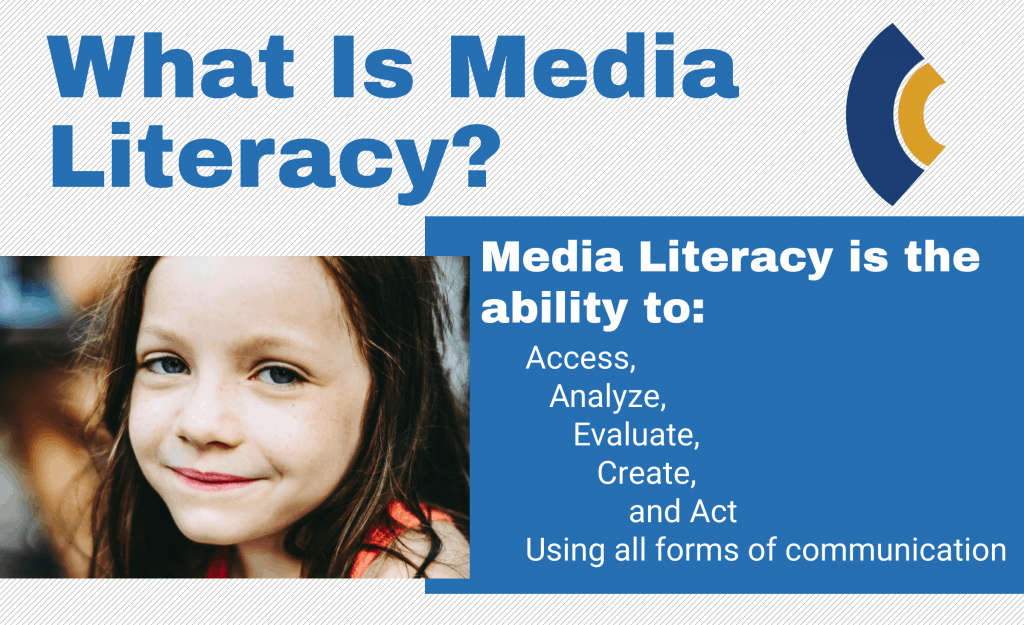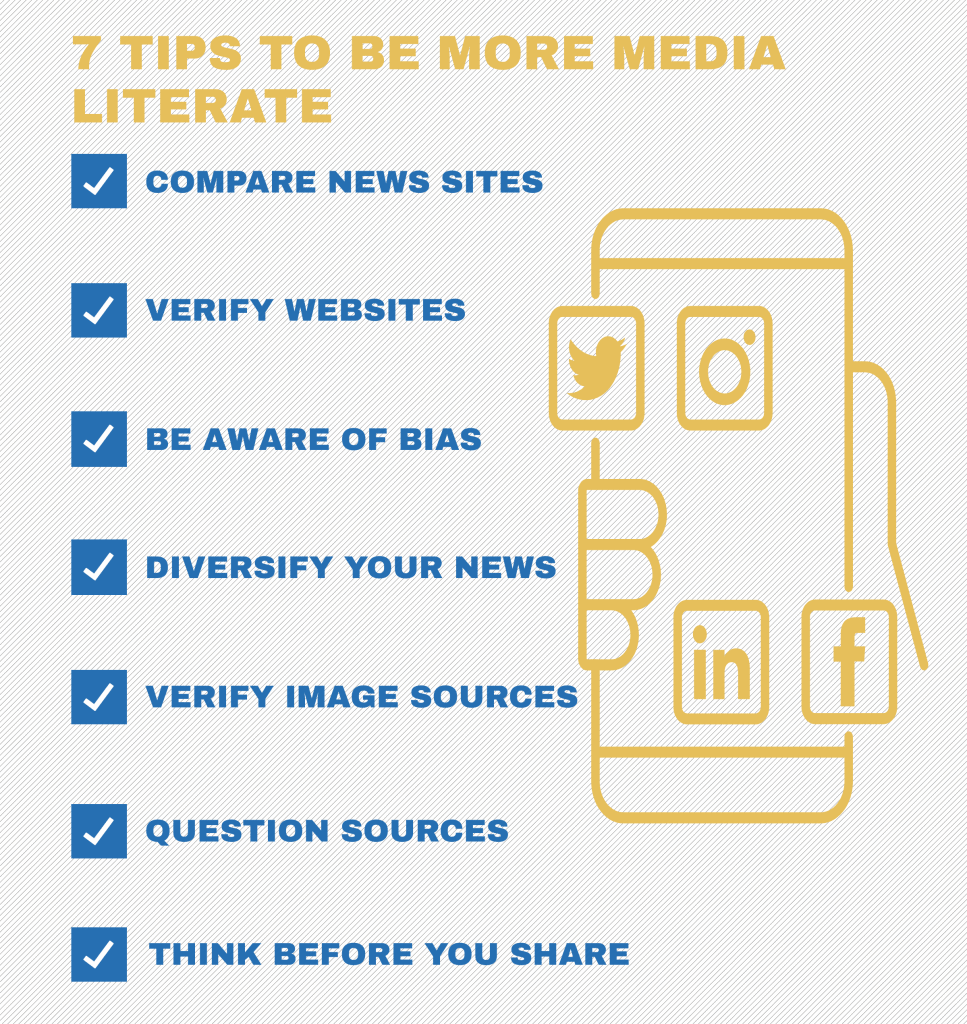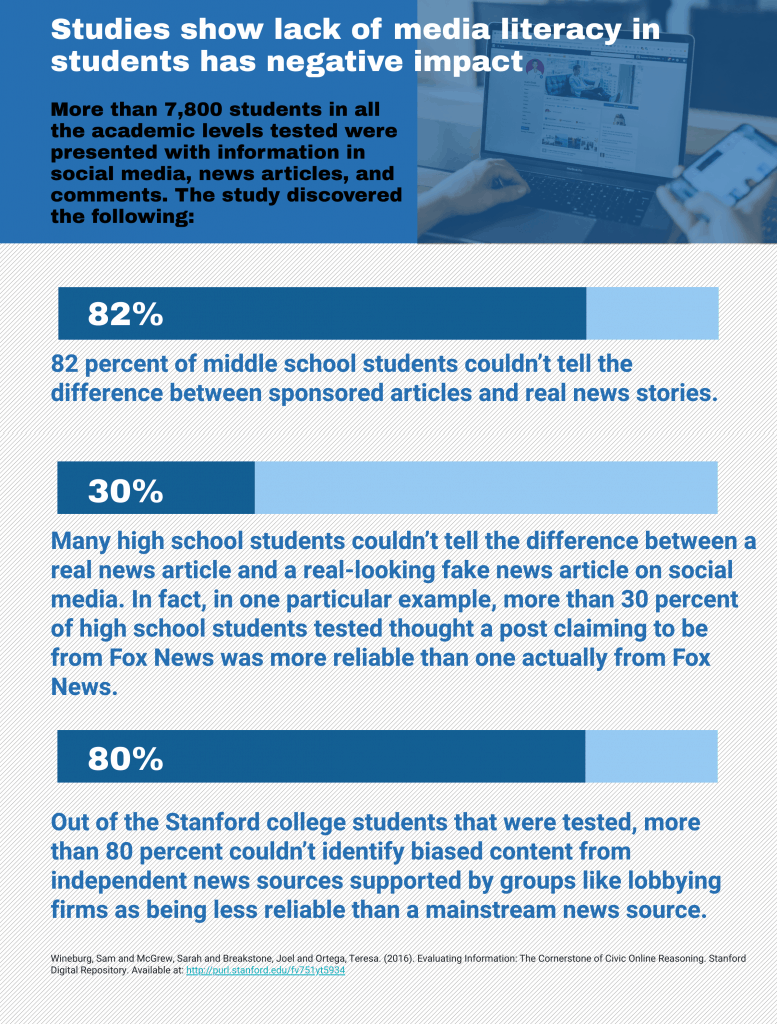Young people today are bombarded with a wealth of information from social media, 24-hour news sources, radio, and traditional newsprint media. It’s more important than ever that children of all ages get an education in how to interpret and analyze the information they’re receiving. Parents and educators can help their children and students become media literate by discussing the latest news cycle with them and explaining how to interpret, fact check, and ask questions about the information that’s being delivered. With online education becoming more common, media literacy is even more critical. Following is a look at how information gets online and into other areas of the media and materials to help parents and educators teach and inform:

What are Bots?
Bots, short for robots, are a type of script that is designed to run autonomously and post up pre-loaded comments onto social media sites. They can be hard to detect due to the fact that conversation on social media is typically disjointed, and posters aren’t expected to respond or be accountable for their comments. Bots are designed to post on their own social media accounts or in response to the hottest topic of the moment. They spread misinformation, look like they were posted by a human, and are designed to be disruptive or influential. Posters don’t always recognize they’re reading a post by a bot because a human set up the account, wrote the post, then arranged for the bot to search for social media posts where its comments can be inserted without scrutiny.
Bots have been around since the early days of the internet. One of their original uses was to scan or scrape content from websites and return that information to search engines. They’re still being used for that purpose and are useful tools in general. It’s when they’re used to post inflammatory or otherwise unhelpful comments on social media sites that bots become problematic.
A bot works like this: a programmer builds a script to run a program that searches for specific words and phrases on a website. The bot can also be programmed to follow a social media account and post comments at random intervals to look as if a human was taking their time writing a reply. All that’s needed is for the programmer to write up a large database of relevant sounding comments for the bot to post at set times for it to look normal.
The reason why bots are a problem comes down to the fact they’re easy to make and don’t require a lot of computing power. All that’s needed is a dedicated computer hooked up to the internet and a timer to run the script. They make sowing discord very easy, and are difficult to detect without engaging in some sleuthing.
What is Meme Culture?
Meme culture is usually a harmless way of communicating an emotion or feeling with an image and a caption. There is a “monkey see, monkey do” element of memes, but that’s mainly restricted to people using the same image to get their point across. Memes are easily relatable, quick to create, and don’t require a lot of explanation for the viewer to get the meaning, gist, or joke. The appeal of the meme is to make a comment about something that’s current without much effort. A good example is on Reddit’s sub of Advice Animals where anonymous posters pick a meme image, put their statement onto the image, then post it for others to comment on, relate to, or join in with snark.
The precursor to memes are something known as demotivational posters. These posters, which are still in use, are akin to motivational posters such as a kitten hanging from a tree branch with the caption of “Hang In There”. However, unlike motivational posters, demotivational posters are likely to have a picture of rows of people sitting at desks and have a saying of “The Beatings Will Continue Until Moral Improves”. Demotivational posters are ironic instead of encouraging. Over time, the demotivational poster evolved into the meme of today.
Overall, memes are harmless in the sense that they don’t stick around for long. A meme is created for a sole purpose and fades away once that purpose has been achieved. The only staying power a meme has is the image that’s used to convey the message, and even then, a meme without context has a shallow meaning.
What are Deep Fakes?
Deep fakes involve overlaying the image of one person onto another in order to make it look as if the original person is actually in the video. Most of the deep fake videos involve a famous personality or politician which can potentially result in serious misinformation getting to the public. An actor can be used to act out the mannerisms and visual expressions of the person that’s intended for imitation, then have the images of said selected individual overlaid onto them through video processing. For example: someone wants to make it look like the President of the United States said something that’s damaging to the U.S. They get an actor who can mimic the president, then overlay images of the president onto the actor with computer software designed for the purpose.
The major issues with deep fakes are the facts that they need a lot of computer processing power along with hundreds, if not thousands, of images of the person that’s the intended target of the deep fake. A typical home computer won’t have the ability to run deep fake software, much less process the final images and turn it into a video. Another problem with deep fakes is that they’re not very polished when it comes to creating their final images. Eyes don’t always move in sync, the face doesn’t move proportionally, and the smoothness of movement are all giveaways that the video is a deep fake.
Deep fakes are most likely going to be a non-issue for the time being as they’re difficult to produce. However, the potential for their misuse is extant, and may become something an issue as improvements to the software are made and the need for computer power gets lower.
Organizations and Associations for Digital Media Literacy
Organizations for digital media literacy are excellent resources for educational materials that help teachers, students, and parents understand the challenges they face with navigating information delivered through digital platforms.
Center for Media Literacy
Develops and provides educational materials and curriculums for educators that include a kit on how to get started and the research behind the curriculums.
American Press Institute
Offers lesson plans and activities to help educators include the news and teach students how to become better consumers of media.
The Center for News Literacy at Stony Brook University
Stony Brook University in New York has spent the past decade developing a curriculum that’s designed to help students develop their critical thinking skills and improve their judgement of the information they receive online, in print, or over the air.
Civic Engagement Research Group
The Civic Engagement Research Group, or CERG, has partnered with the LEADE Initiative and created a set of lesson plans for educators to use in the classroom. The plans involve activities that include recreating what it was like to vote in the 2020 election and a toolkit on digital civics.
Facing History & Ourselves
Facing History & Ourselves offers materials and resources that help teachers quickly create a lesson plan for the following day. The classroom resources are designed to address current events in the media so teachers can address the topic in their classrooms the day after they happen.
Common Sense Education
Common Sense Education offers classroom materials and curriculums for students K-12 and offers support for teachers who want to develop strategies to teach students digital media literacy. It also has in-depth reviews of games, websites, and apps for use in the classroom.

Articles and Statistics on Media Literacy
The 24-hour news cycle has evolved to become more influential than ever before. Many news outlets are full of soundbites and commentators that are legally allowed to put forth their version of the truth as they see it. Now these news sources, once seen as trustworthy, are making Americans question what’s real, and what is not. The time is now to start teaching children and teenagers about digital media literacy in order to help them form their own critical thinking skills and ability to parse the information they’re receiving on TV and through social media sites.
American Press Institute Survey on Journalistic Values
This study asks the question of “Do Americans share journalism’s core values?” and examines how people’s personal moral codes and values do or don’t support the value of journalism in a time when journalistic values are constantly being challenged and questioned by the media.
Key Concepts for Media Literacy
Media Smarts breaks down the importance of teaching media literacy and how it encourages young people to become analytical and critical of the multimedia culture. It also discusses how to best approach describing media products and how to present it to students.
Fake News, Phishing, and Fraud
The paper discusses the fact that there’s a lot of research for the effects of digital media literacy on children, but little for adults. The paper discusses the fact that misinformation and scams are easily spread among the adult population, but there’s little in the way of research on effective digital media literacy instructional interventions for older adults.
An Approach to Digital Literacy
The authors of this paper outline two educational practices that equip the user with the ability to function in digitally rich societies. It’s comprised of three sections that discuss the history of information literacy, the concept of media literacy, and argues that there’s a large body of understanding about digital and media literacy, there are still deficiencies in how people are taught to understand and process both types of literacies.
Fake Images
This study consists of determining how people evaluate image credibility through a large study of users pulled randomly from Amazon Mechanical Turk. The study used news-source mockups that used a forged image, then asked participants to evaluate the credibility of the images using certain features. The study found that a user’s ability to determine if an image was fake depended on their knowledge of the internet, photo-editing skills, and social media use.
Can Media Literacy Education Increase Digital Engagement in Politics?
This studey examines the potential for engaging youth in political culture through the use of digital engagement literacies, strategies for doing so, and how well they work. A panel survey found that educators who make the effort to get youth to participate through digital engagement literacies help mobilize youth groups in applying pressure to governments, corporations, and nonprofits.
The Building Blocks of Digital Media Literacy
The article discusses the knowledge and skills that students develop when engaged in digital media production and analysis in a school setting. An argument is made about how the two established approaches to media literacy education, critical reading and media production aren’t doing a good job of explaining how students develop their knowledge in these areas.
Does Media Literacy Help Identification of Fake News?
A look at the prevailing assumption that an educated audience is capable of spotting fake news and are protected against the harmful effects of misleading information. The study investigates the assumption that an audience that engages in literacy interventions have a higher likelihood of identifying fake news, and also raises questions about the self-reported competencies that are commonly used in literacy scales.
Digital and Media Literacy in Pre-Service Teacher Education
This case study from Switzerland focuses on the concept of educating teachers about digital and media literacy during their pre-service education. The study collected data on how pre-service teachers felt about their approach to the topic, how to implement digital and media literacy education to their classes, and the difference they could make with their student’s understanding of the topic.
Books and Games for Media Literacy
Media Literacy in the K-12 Classroom, by Frank W. Baker
Includes topics to discuss with students such as advertising, bias, critical thinking and has a curriculum, lesson plans, and informational texts.
Close Reading the Media – Literacy Lessons and Activities for Every Month of the School Year by Frank W. Baker
Discusses the blurring of digital media and daily life and how it’s complicated daily life, and has questions that should be asked of students to help prepare them to question the information they’re receiving.
Mastering Media Literacy Edited by: Heidi Hayes Jacobs
Helps teachers incorporate digital media literacy into their curriculum by merging media literacy with other areas of learning, design rubrics to evaluate content knowledge and knowledge of technology tools, and teach students how to evaluate the validity of media.
LAMBOOZLED!: The Media Literacy Card Game
LAMBOOZLED! is intended for students age 11 and older. It aids the students in improving their critical media literacy skills without the use of partisan politics. It gets its name from its premise of teaching sheep how to avoid getting the wool pulled over their eyes.
Media Literacy: An essential guide to critical thinking skills for our complex digital world by Nick Pernisco
A straightforward guide for teachers to help students understand media literacy and how to share that understanding with others.
Media Literacy in Action: Questioning the Media by Renee Hobbs
Discusses the close relationship students have with media, and presents critical questions teachers can ask of students to examine their relationship with media. The questions are designed to help students become responsible communicators with their peers.
Mental Health / Cyberbullying
Digital media can often play a role in mental health and cyberbullying issues. The following resources are designed to help parents and educators prevent and deal with the issues:
Cyberwise
Offers free materials and curriculums for teachers and parents who want to teach their children about cyberbullying, sexting, limiting sharing of information on social media, and other digital media literacy issues.
StopBullying.gov
A resource from the federal government for parents and teachers to recognize bullying behaviors, how to prevent the issue, and lists local laws regarding the issue.
Digizen.org
Informational resource to aid parents and teachers in the education of their children and students about digital citizenship, cyberbullying, and how online behaviors affect real life behaviors.
American Psychological Association
Defines bullying from a psychological standard and provides materials to help parents and teachers prevent bullying at all ages and in common social situations.
Cyberbullying Research Center
Provides research, statistics, analysis of current cyberbullying trends, and educational materials for parents, teachers, and administrators to use at home, in the classroom, and the assembly area.
Embrace Civility
Embrace Civility has a mission statement to provide guidance to adults who want to engage students in making positive relationships and act civilly with one another instead of being mean and aggressive.

Other Resources
Here are some other resources that help parents and teachers find ways to deal with and teach students how to understand the issues of digital literacy:
Crash Course Youtube video series
A video series made up of short videos that discuss how the internet is an excellent information resource, but how it’s also used to spread misinformation.
Edutopia
Consists of 9 videos covering news literacy and designed to help teachers show their students how to detect fact or fiction in the news.
Five Key Questions That Can Change the World
An introductory guide to help teachers introduce the topic of media literacy. The PDF contains 25 lesson plans and comes in English and Spanish languages.
CRAAP test
CRAAP is short for:
- Currency
- Relevance
- Authority
- Accuracy
- Purpose
Each of these sections is a standard for judging the validity of a news article, and also teaches how to apply one’s understanding of media literacy.
Campus Organizations for Media Literacy
Campus organizations are designed to help educate students on media literacy. They offer a non-classroom setting where students can gain understanding of the challenges they face when looking and listening to various news outlets online, television, and radio. Students should be encouraged to express their opinions and views in order to help them understand the validity of their point of view along with presenting arguments as to why their view should be challenged.
Related:

